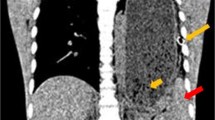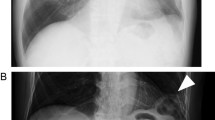Abstract
Traumatic diaphragmatic hernia is a rare injury in children. The diagnosis is often delayed because of nonspecific clinical and radiologic findings. We report the CT findings in two children with visceral herniations, one hepatic and one gastric, resulting from traumatic rupture of the diaphragm.
Motor-vehicle accidents are the most common cause of acquired diaphragmatic hernia in children [1]. Because it is rare and often overshadowed by associated injuries, the diagnosis of posttraumatic diaphragmatic rupture is often delayed [1, 2]. We show how CT can aid visualization of the diaphragm or reveal associated findings leading to the diagnosis of diaphragmatic rupture.
Similar content being viewed by others
References
Adeyemi SD, Stephens CA (1981) Traumatic diaphragmatic hernia in children. Can J Surg 24:355–357
Holm A, Bessey PQ, Alderete JS (1988) Diaphragmatic rupture due to blunt trauma: morbidity and mortality in 42 cases. South Med J 81:956–962
Haller JA (1986) Thoracic injuries. In: Welch KJ, Randolph JG, Ravitch MM, O'Neill JA, Rowe MI (eds) Pediatric surgery. Year Book, Chicago, pp 143–153
Bernatz PE, Burnside AF, Clagett OT (1958) Problem of the ruptured diaphragm. JAMA 168:877–881
Fraser RG, Pare JAP, Pare PD, Fraser RS, Genereux GP (1991) Diseases of the thorax caused by external physical agents. In: Diagnosis of diseases of the chest, 3rd edn. Saunders, Philadelphia, pp 2480–2571
Ball T, McCrory R, Smith JO, Clements JL (1982) Traumatic diaphragmatic hernia: errors in diagnosis. AJR 138:633–637
Ammann AM, Brewer WH, Maull KI, et al (1983) Traumatic rupture of the diaphragm: real-time sonographic diagnosis. AJR 140:915
Demos TC, Solomon C, Posniak HV, Flisak MJ (1989) Computed tomography in traumatic defects of the diaphragm. Clin Imaging 13:62–67
Holland DG, Qunit LE (1991) Traumatic rupture of the diaphragm withoyt visceral herniation: CT diagnosis. AJR 157: 17–18
Gurney J, Harrison WL, Anderson JC (1985) Omental fat simulating pleural fluid in traumatic diaphragmatic hernia: CT characteristics. J Comput Assist Tomogr 9:1112–1114
Leekman RN, Ilves R, Shankar L (1987) Inversion of gallbladder secondary to traumatic herniation of liver: CT findings. J Comput Assist Tomogr 11:163–164
Fagan CJ, Schreiber MH, Amparo EG, Wysong CB (1979) Traumatic diaphragmatic hernia into the pericardium: verification of diagnosis by computed tomography. J Comput Assist Tomogr 3:405–408
Author information
Authors and Affiliations
Rights and permissions
About this article
Cite this article
Catasca, J.V., Siegel, M.J. Posttraumatic diaphragmatic herniation: CT findings in two children. Pediatr Radiol 25, 262–264 (1995). https://doi.org/10.1007/BF02011094
Received:
Accepted:
Issue Date:
DOI: https://doi.org/10.1007/BF02011094




